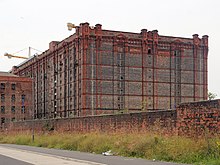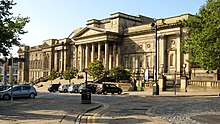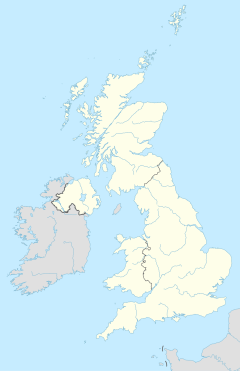Liverpool Maritime Mercantile City
| Liverpool Maritime Mercantile City | |
|---|---|
 Liverpool Pier Head | |
| General information | |
| Architectural style | Victorian |
| Location | Liverpool, North West England, England, United Kingdom |
| Coordinates | 53°24′24″N 2°59′40″W / 53.40667°N 2.99444°W |
| Construction started | 1841 |
| Completed | 1847 |
| Inaugurated | 1846 |
Former UNESCO World Heritage Site | |
| Official name | Liverpool – Maritime Mercantile City |
| Criteria | Cultural: (ii), (iii), (iv) |
| Designated | 2004 (28th session) |
| Reference no. | 1150 |
| Region | Europe and North America |
| Delisted | 2021 (44th session) |
| Website | |
| www | |
Liverpool Maritime Mercantile City is a former UNESCO designated World Heritage Site in Liverpool, England, that comprised six locations in the city centre including the Pier Head, Albert Dock and William Brown Street,[1] and many of the city's most famous landmarks.
UNESCO received
In 2012, the site was added to the List of World Heritage in Danger due to the proposed Liverpool Waters project. In 2017, UNESCO warned that the site's status as a World Heritage Site was at risk of being revoked in light of contemporary development plans, with English Heritage asserting that the Liverpool Waters development would leave the setting of some of Liverpool's most significant historic buildings "severely compromised", the archaeological remains of parts of the historic docks "at risk of destruction", and "the city's historic urban landscape [...] permanently unbalanced."[4]
In 2021,
Locations
The Liverpool Maritime Mercantile City comprised six separate locations throughout the centre of the city, each of which related to a different component and time in Liverpool's maritime history.[7] The inscribed sites extended for approximately 4 km (2+1⁄2 miles) north-south along the city's waterfront and stretched approximately 1 km (1⁄2 mile) east-west.[8] In total it covered an area of 136 ha (340 acres).[9]
Pier Head
The Pier Head is the focal point of Liverpool's waterfront and is dominated by three of its most recognisable landmarks: The

Listed buildings[10]
|
|
Albert Dock
The
Listed buildings[18]
|
|

Stanley Dock Conservation Area
The Stanley Dock Conservation Area is located to the north of the
Listed buildings[19]
- Warehouse on North Side of Stanley Dock (Grade II*)
- Bonded Tea Warehouse, Great Howard Street (Grade II)
- Clarence Graving Docks (Grade II)

Stanley Dock Tobacco Warehouse
- Boundary Wall from Collingwood Dock to Huskisson Dock (Grade II)
- The Dock Master's Office, Salisbury Dock (Grade II)
- Salisbury, Collingwood and Stanley, Nelson and Bramley-Moore Dock Retaining Walls (Grade II)
- Stanley Dock Tobacco Warehouse (Grade II)
- Entrances to Stanley Dock Complex (Grade II)
- Canal Locks between Stanley Dock and Leeds and Liverpool Canal (Grade II)
- Princes Dock Boundary Wall and Piers (Grade II)
- Salisbury, Collingwood and Stanley, Nelson and Bramley-Moore Dock Retaining Walls (Grade II)
- Hydraulic Tower West of North Stanley Warehouse (Grade II)
- Victoria Tower (Grade II)
- Warehouse South of Stanley Tobacco Warehouse (Grade II)
- Waterloo Warehouse (Grade II)
Duke Street
The RopeWalks site comprises the southwestern component of the Duke Street conservation area, as well as two warehouses on College Lane and Bluecoat Chambers on School Lane. The location was one of the first areas in the city to develop when Liverpool was an emerging port,[22] with Bluecoat Chambers being the oldest surviving building in Liverpool city centre, dating back to 1715.[23] Its proximity to the Old Dock, the world's first enclosed wet dock,[24] meant it was the location of the city's first property speculators who built both warehousing and residential premises along Duke St, Hannover St, and Bold St. The area soon developed a cosmopolitan feel being home to various types of people including sea captains, merchants, traders and artisans. Today the area is known as Ropewalks, a reference to the large number of roperies present in the area when Liverpool was one of the busiest ports in the world during the 18th and 19th centuries.[22]
Listed buildings[22]
|
Castle Street
This part of the WHS is focused around what would have previously been medieval Liverpool and includes Castle Street dominated by Trials Hotel at one end and the Town Hall at the other linking Old Hall Street by Exchange Flags, Victoria Street, Water Street and Dale Street. Today a centre for commercial activity in the city, the area was included due to the nature of its street development over three centuries and the grandeur of its architecture and monuments.[25]
Listed buildings

|
William Brown Street


The William Brown street area is the central point for many of Liverpool's civic buildings forming a so-called cultural quarter. Amongst the buildings that are focal to this area are
Listed buildings[26]
|
|
Inscription
Having received the nomination for the area in January 2003, the International Council on Monuments and Sites (ICOMOS) travelled to Liverpool in September of that year to carry out an evaluation on behalf of UNESCO. The ICOMOS evaluation analysed the city in relation to its nomination document, looking at four key areas: conservation, authenticity and integrity, comparative evaluation and outstanding universal value.[2]
- Conservation – In terms of conservation status ICOMOS were happy that a wide range of buildings from the 18th through to 20th century were preserved within the city, despite two world wars and significant decline during the 1970s. However, they keenly stressed the importance of continued preservation suggesting that all future developments within the nominated areas are stringently monitored.
- Authenticity and integrity – ICOMOS were pleased with manner in which the nominated areas had maintained the majority of their historical integrity, despite some major regeneration and development projects since the Second World War. The urban fabric of the six sites ranged from the 18th to 20th century and the committee were happy that the city's street pattern provided a readable representation of different periods in Liverpool's history.
- Comparative evaluation – As part of their evaluation ICOMOS compared Liverpool's maritime history with that of other major ports throughout both the UK and wider world. They felt that Liverpool had values and qualities that set it apart from many other port cities both in terms of its maritime function and architectural and cultural significance.
- Outstanding universal value – In analysing Liverpool's Maritime Mercantile City in terms of its universal value, ICOMOS concurred with the local council that Liverpool was the 'supreme example of a commercial port at the time of Britain's greatest global influence'. In particular they noted the role the city played in the trans-Atlantic slave trade, the development of docking technology and railway transportation, and the attention given to cultural activities and architecture.
Upon completion of their evaluation, ICOMOS returned to UNESCO with the recommendation that the area be inscribed as a world heritage site. At the same time they made several recommendations regarding future preservation and development within the areas and their buffer zones.[2] As a result, the Liverpool Maritime Mercantile City was inscribed as a World Heritage Site at the 28th session of the World Heritage Committee in 2004, under the cultural criteria ii, iii and iv:[27]
- Criterion (ii): "Liverpool was a major centre generating innovative technologies and methods in dock construction and port management in the 18th and 19th centuries. It thus contributed to the building up of the international mercantile systems throughout the British Commonwealth."
- Criterion (iii): "The city and the port of Liverpool are an exceptional testimony to the development of maritime mercantile culture in the 18th and 19th centuries, contributing to the building up of the British Empire. It was a centre for the slave trade, until its abolition in 1807, and for emigration from northern Europe to America."
- Criterion (iv): "Liverpool is an outstanding example of a world mercantile port city, which represents the early development of global trading and cultural connections throughout the British Empire."
Revocation of World Heritage status

In 2010, the
On 21 June 2021, just before the World Heritage Committee's 44th session in Fuzhou, China, the UN institution published a draft report recommending removal of Liverpool Maritime Mercantile City from its World Heritage Site list, citing non-compliance of UK and local authorities with UN recommendations and extensive modern development that adversely impacted the area.[36][37] The next month, on 21 July, the World Heritage Committee voted 13–5, with 2 abstentions, to remove the status of World Heritage Site from Liverpool Maritime Mercantile City, citing "irreversible loss of attributes conveying the outstanding universal value of the property".[6][38] It is the third site ever to be struck from the UNESCO list.[39]
Reactions
The decision was met with condemnation from British government officials on various levels. The then Mayor of Liverpool, Joanne Anderson, described it as "incomprehensible" and stated that the World Heritage Site had benefitted from large investments which UNESCO had not appreciated. She also added that the city would consider an appeal against the decision.[40] Similarly, Steve Rotheram, leader of the Liverpool City Region, criticised the vote as being unreflective of the situation at the place, and added that places like Liverpool should not choose between heritage status and development.[32] A spokesman for the UK government also expressed disappointment and said that Liverpool still deserved the World Heritage Status.[41]
Chris Capes, a representative of the Peel Group, which develops Liverpool Waters, insisted that despite delisting of Liverpool (which he considered very disappointing), regeneration and protection of the city's heritage could go together.[42] Additionally, Michael Parkinson, a professor of the University of Liverpool who has worked on urban regeneration, wrote that Liverpool's docks were derelict and in need of revitalisation, and suggested that UNESCO employed double standards.[43] He also cited an article which said that the heritage site with an area of 136 hectares and 380 buildings was probably too large.[44]
Among conservation groups, the decision of UNESCO was met with mixed reactions. Gavin Davenport, chair of the Merseyside Civil Society, was critical of the decision and suggested that UNESCO come to
See also
References
Notes
- ^ "Liverpool – Maritime Mercantile City". UK Local Authority World Heritage Forum. Archived from the original on 23 April 2008. Retrieved 9 October 2008.
- ^ ICOMOS. 2004. Retrieved 9 December 2008.
- ^ "Welcome to Liverpool World Heritage". Liverpool City Council. Archived from the original on 22 February 2008. Retrieved 9 October 2008.
- ^ a b Perraudin, Frances (3 October 2017). "Liverpool faces up to world heritage removal threat with taskforce". the Guardian.
- ^ a b "Bramley-Moore Dock: Everton cleared to build new £500m stadium". BBC News. 26 March 2021. Retrieved 21 July 2021.
- ^ a b "Liverpool stripped of Unesco World Heritage status". BBC News. 21 July 2021.
- Visit Britain. Retrieved 9 October 2008.
- ^ Liverpool City Council (2005), p17
- ^ Liverpool City Council (2005), p26
- ^ a b "Pier Head". World Heritage Liverpool. Archived from the original on 7 February 2009. Retrieved 10 December 2008.
- ^ "Museum of Liverpool". Liverpool museums. Retrieved 6 February 2012.
- ^ "Building a New Museum". National Museums Liverpool. Retrieved 30 October 2008.
- ^ "George's Dock Ventilation". Liverpool World Heritage. Retrieved 10 December 2008.
- ^ "Memorial to the Engine Room Heroes of the Titanic". Liverpool World Heritage. Retrieved 10 December 2008.
- ^ Jones, Ron (2004). The Albert Dock, Liverpool. RJ Associates Ltd. p. 83.
- ^ Jones, Ron (2004). The Albert Dock, Liverpool. RJ Associates Ltd. p. 46.
- ^ Helen Carter (7 March 2003). "Glory of Greece, grandeur of Rome ... and docks of Liverpool". Guardian Unlimited. Retrieved 27 March 2007.
- ^ "The Albert Dock Conservation Area". Liverpool World Heritage. Retrieved 11 March 2009.
- ^ a b "The Stanley Dock Conservation area". Liverpool World Heritage. Archived from the original on 6 May 2008. Retrieved 7 March 2009.
- ^ "Clarence Graving Docks". Liverpool World Heritage. Retrieved 9 March 2009.
- ^ "The Stanley Dock Tobacco Warehouse". Liverpool World Heritage. Archived from the original on 4 December 2008. Retrieved 7 November 2008.
- ^ a b c "Duke Street Area/Ropewalks". Liverpool World Heritage. Archived from the original on 26 June 2009. Retrieved 1 November 2008.
- ^ Pollard, Richard; Nikolaus Pevsner (2006). The Buildings of England: Lancashire: Liverpool and the South-West. New Haven & London: Yale University Press. pp. 302–304.
- ^ "Trading Places: Old Dock History". National Museums Liverpool. Archived from the original on 24 March 2008. Retrieved 1 November 2008.
- ^ "Castle/Dale/Old Hall St Commercial Centre". Liverpool World Heritage. Archived from the original on 19 July 2008. Retrieved 6 November 2008.
- ^ a b "William Brown St Conservation Area". Liverpool World Heritage. Archived from the original on 26 July 2011. Retrieved 14 September 2009.
- ^ "Nominations of Cultural Properties to the World Heritage List (Liverpool – Maritime Mercantile City)". UNESCO. Retrieved 23 October 2008.
- ^ "Ferry terminal's Carbuncle award". BBC News. 4 September 2009. Retrieved 22 July 2020.
- ^ Carter, Helen (24 January 2012). "Liverpool's world heritage waterfront faces 'irreversible damage', report says". The Guardian. Retrieved 21 July 2021.
- ^ Buckley, Julia (21 July 2021). "Liverpool stripped of its UNESCO World Heritage listing". CNN. Retrieved 21 July 2021.
- ^ Gardiner, Joey. "Why Liverpool faces a threat to its World Heritage Site's status". www.planningresource.co.uk. Retrieved 21 July 2021.
- ^ a b "Liverpool stripped of Unesco World Heritage status". BBC News. 21 July 2021. Retrieved 21 July 2021.
- ISSN 0013-0613. Retrieved 21 July 2021.
- ^ "The Caller Report – What next for Liverpool? – Articles – Heseltine Institute for Public Policy, Practice and Place – University of Liverpool". University of Liverpool. Retrieved 21 July 2021.
- ^ "A watershed moment: What now for Liverpool?". BBC News, 15 April 2021.
- ^ "Unesco report says Liverpool should lose World Heritage status". BBC News. 21 June 2021. Retrieved 21 July 2021.
- ^ Item 7A of the Provisional Agenda: State of conservation of the properties inscribed on the List of World Heritage in Danger (PDF). Paris: UNESCO. 2021. pp. 52–58.
- ^ "World Heritage Committee deletes Liverpool – Maritime Mercantile City from UNESCO's World Heritage List". UNESCO. 21 July 2021. Retrieved 21 July 2021.
- ^ Halliday, Josh (21 July 2021). "Unesco strips Liverpool of its world heritage status". The Guardian. Retrieved 21 July 2021.
- ^ Buckley, Julia (21 July 2021). "Liverpool stripped of its UNESCO World Heritage listing". CNN. Retrieved 21 July 2021.
- ISSN 0362-4331. Retrieved 21 July 2021.
- ^ Capes, Chris (21 July 2021). "Regeneration and the protection of Liverpool's heritage can happen together". Liverpool Waters. Retrieved 21 July 2021.
- ^ Parkinson, Michael. "I've been chronicling Liverpool's renaissance for 40 years – here's why the city's Unesco status should not have been removed". The Conversation. Retrieved 21 July 2021.
- ^ Chambers, William (2020). "Liverpool 2008 World Heritage Site(s): To Keep or To Lose?". Cultural Resilience: Physical Artifacts, Intangible Attributes, Possible Risks (PDF). Sibiu: Lucian Blaga University of Sibiu Press. p. 11.
- ^ Davenport, Gavin (21 July 2021). "Liverpool's heritage is not under threat | Letter". The Guardian. Retrieved 21 July 2021.
- ISSN 0307-1235. Retrieved 22 July 2021.
- ^ Thorp, Liam (22 June 2021). "'Disappointment' over move to strip city of World Heritage status". Liverpool Echo. Retrieved 22 July 2021.
- ^ O’Donnell, Joe (21 July 2021). "Victorian Society saddened by the loss of Liverpool's World Heritage status". The Victorian Society. Retrieved 22 July 2021.
- ^ a b "PRESS RELEASE: SAVE regrets loss of Liverpool World Heritage status". Save Britain's Heritage. 21 July 2021. Retrieved 22 July 2021.
Bibliography
- Liverpool City Council (2005). Maritime Mercantile City: Liverpool. ISBN 1-84631-006-7.
- Oevermann, H.; Mieg, H.A., eds. (2014). Industrial Heritage Sites in Transformation: Clash of Discourses. ISBN 978-0415745284.






